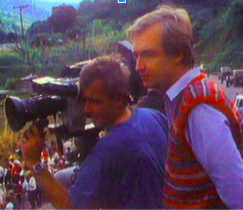Along with Kate, Matt, Sawyer, and Sydney, I presented on the documentaries The World is Watching (1988) and The World Stopped Watching (2003) directed by Canadian Peter Raymont. One of the recurring themes in these films is the role of journalists covering Nicaragua. Is it to entertain the public back home? Provide as objective a narrative as possible on the events they cover? Support the policies of the American government? Or, as Newsweek photographer Bill Gentille stated in the film, “One of the facets of journalism is that we as journalists have to help set the agenda — not just pander to the lowest common denominator of reader or viewer interest. We have to converge to a certain degree, with the people and the causes and the movements that we believe are important and fight along with them to reach a higher goal. That’s our job.”
The melodrama Under Fire (1983) directed by Roger Spottiswoode and presented in class by Louise, Leah, Billy, and Clement exemplifies the type of journalism presented in this quote. The movie follows American journalists Russell Price, Alex Grazier, and Claire Stryder as they cover the 1979 Sandinista revolution in Nicaragua in the weeks before the fall of the Somoza dictatorship. When the revolutionary leader Rafael dies, his Sandinista followers ask the journalists to photograph the leader as if he were alive in order to preserve his popular support. By now sympathetic with the Sandinista cause, Russ decides to take the photo and subvert the truth. The film heroizes this choice to become personally invested in toppling the repressive Somoza regime rather than remaining detached (and insensitive) American journalists. In the words of Bill Gentille, they chose to “fight along with [the Sandinistas] to reach a higher goal.”
While obviously an extreme example, I believe Under Fire reveals the problems in Bill Gentille’s interpretation of journalistic responsibility. Journalists—especially abroad—hold a huge amount of power and influence. The public trusts them to be their eyes and ears abroad. By taking the photograph of Rafael, Claire and Russ abuse the power they have as journalists for what they believe is the greater good. But they are not acting as individuals. They’re the vanguard of American public opinion and thus have a responsibility to their audience to be truthful. (Truthful is not necessarily objective. It is important to admit bias, which is a problem explored in The World is Watching). While Russ and Claire are fighting for what they believe is a “higher goal,” whose to say they’re in the right? If the role of a journalist is to fight for the movements they believe are important then they’re producing propaganda disguised as news. If every journalist followed their own agenda then the public would lose trust in the institution of journalism. With Americans’ trust in mass media falling to an all time low, this is actually what is happening in the United States today. Under Fire fails to interrogate the broader consequences of journalistic deceit and breaches in public trust.


